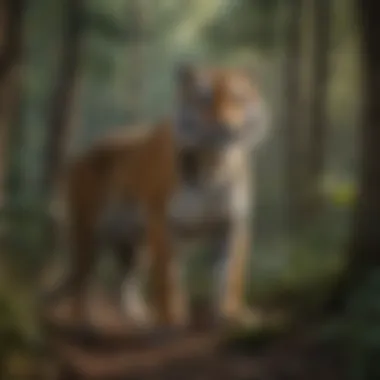Safeguarding Wildlife: Expert Strategies for Protection


Forest Management Techniques
Forest management is a critical aspect of safeguarding wildlife habitats and ensuring the sustainability of ecosystems. This section delves into the various techniques employed to manage forests effectively and responsibly.
Wildlife Habitat Preservation
Preserving wildlife habitats is essential for maintaining biodiversity and supporting numerous species within the ecosystem. Strategies such as creating protected areas, establishing corridors for animal movement, and managing invasive species play a crucial role in habitat preservation.
Sustainable Logging Practices
Sustainable logging practices are imperative to mitigate the impact of timber harvesting on forest ecosystems. By promoting selective cutting, replanting harvested areas, and adhering to certified forestry practices, sustainable logging helps preserve the integrity of the forest landscape while meeting the demand for wood products.
Fire Prevention Measures
Forest fires pose a significant threat to wildlife habitats and the environment. Implementing fire prevention measures such as controlled burns, early detection systems, and community fire awareness programs can help minimize the risk of wildfires and protect forests from extensive damage.
Ecosystem Restoration Initiatives
Restoring degraded lands and ecosystems is a multifaceted approach to promoting biodiversity and enhancing the resilience of forested areas. Through reforestation projects, habitat restoration efforts, and the rehabilitation of ecosystems, restoration initiatives aim to revitalize landscapes and support the ecological balance.
For forestry professionals and academics, understanding and implementing effective forest management techniques are pivotal in safeguarding wildlife and maintaining healthy ecosystems.
Understanding Wildlife Conservation
In the realm of wildlife defense strategies, understanding wildlife conservation holds paramount significance. To grasp the intricacies and importance of preserving nature's biodiversity and ecosystems, one must delve deep into the tapestry of conservation efforts. By shedding light on the multifaceted approach required to protect diverse species and their habitats, this section serves as a foundational pillar in the ultimate guide to safeguarding wildlife.
The Importance of Wildlife Preservation
Ecosystem Stability
Ecosystem stability stands at the core of wildlife preservation, playing a crucial role in maintaining the delicate balance of nature. This aspect underscores the resilience and functionality of ecosystems, ensuring that flora and fauna coexist harmoniously. The resilience of ecosystems contributes to the overall well-being of wildlife populations, making it a pivotal consideration in devising effective conservation strategies within the context of this article.
Biodiversity Preservation
Biodiversity preservation serves as a critical component in the realm of wildlife defense, emphasizing the rich tapestry of life forms existing in various habitats. The significance of biodiversity lies in its role in promoting ecosystem health and adaptability to external stresses. By conserving diverse species and genetic variability, biodiversity preservation fosters resilience in the face of environmental challenges, making it an indispensable focus area for this comprehensive guide.


Challenges Faced by Wild Animals
Habitat Loss
Habitat loss poses a formidable challenge to wild animals, as human activities continue to encroach upon natural habitats. This phenomenon disrupts ecosystems, leading to the displacement of species and a loss of biodiversity. The impact of habitat loss reverberates across all levels of the food chain, underscoring the urgent need to address this pressing issue within the scope of wildlife conservation efforts explored in this article.
Climate Change Impact
The far-reaching consequences of climate change extend to wildlife populations, affecting their habitats and food sources. The altering climatic conditions pose a threat to the survival of various species, pushing them towards the brink of extinction. Understanding the intricate interplay between climate change and wildlife underscores the importance of implementing adaptive measures to mitigate the adverse effects on vulnerable animal populations, a crucial focus of this guide.
Role of National Parks and Reserves
Biodiversity Hotspots
Biodiversity hotspots represent regions of immense ecological importance, harboring a wealth of species found nowhere else on the planet. These areas serve as key habitats for countless wildlife populations, embodying the richness and complexity of Earth's biodiversity. Recognizing the significance of conserving biodiversity hotspots entails prioritizing the protection of unique species and ecosystems, aligning with the overarching goals of wildlife defense elucidated in this article.
Conservation Programs
Conservation programs play a pivotal role in safeguarding wildlife by implementing targeted initiatives to preserve endangered species and habitats. These programs encompass a wide array of conservation efforts, ranging from habitat restoration to community engagement. The efficacy of conservation programs lies in their adaptive and collaborative nature, engendering a shared responsibility towards preserving the natural heritage for future generations, a central theme encapsulated in this comprehensive wildlife defense guide.
Combatting Illegal Wildlife Trade
This section delves into a crucial aspect of wildlife conservation - combatting the illegal wildlife trade. The illegal trade in wildlife and wildlife products is a multi-billion dollar industry that poses a significant threat to various species around the globe. By addressing this illicit activity, we can safeguard the biodiversity of our planet and ensure the protection of vulnerable species for future generations.
Overview of Poaching and Trafficking
Endangered Species Targets
Poaching remains a primary driver of the illegal wildlife trade, with many endangered species falling victim to this barbaric practice. Endangered species are targeted for their rarity and value in the black market, leading to plummeting population numbers and even extinction threats for some iconic animals. The focus on endangered species underscores the urgency and severity of wildlife crime, emphasizing the need for stringent measures to combat these activities.
Global Implications
The global implications of wildlife trafficking extend far beyond individual species and ecosystems. The interconnected nature of wildlife trade links regions worldwide, influencing local communities, economies, and biodiversity on a global scale. The ramifications of unchecked wildlife crime reverberate across borders, impacting not only wildlife populations but also human livelihoods and international security. Addressing the global implications of wildlife trafficking is essential for fostering sustainable development and conservation efforts worldwide.
Enforcement Measures and Legal Frameworks


International Agreements
International agreements play a vital role in combating illegal wildlife trade by promoting cooperation among nations and setting standards for wildlife protection. Accords such as CITES (Convention on International Trade in Endangered Species of Wild Fauna and Flora) facilitate the regulation of wildlife trade and harmonize conservation efforts on an international level. These agreements enhance enforcement mechanisms and legal frameworks, ensuring the conservation and sustainable use of wildlife resources.
Anti-Poaching Strategies
Anti-poaching strategies serve as frontline defenses against wildlife crime, aiming to deter and apprehend poachers engaging in illegal activities. These strategies encompass a range of tactics, including increased patrolling, technological surveillance, and community engagement. By implementing effective anti-poaching measures, authorities can reduce the pressure on wildlife populations and disrupt illicit wildlife supply chains, safeguarding vulnerable species from exploitation.
Community Involvement in Combatting Wildlife Crime
Awareness Campaigns
Raising awareness among local communities is pivotal in combatting wildlife crime, as informed communities are better equipped to detect and report illegal activities. Awareness campaigns educate the public about the impacts of wildlife trafficking, instilling a sense of environmental stewardship and fostering a culture of conservation. By engaging communities in conservation efforts, we empower individuals to become advocates for wildlife protection, creating a network of vigilant conservationists committed to combating wildlife crime.
Local Empowerment
Local empowerment initiatives empower communities to take ownership of wildlife protection efforts, promoting sustainable practices and fostering partnerships between locals and conservation organizations. By involving communities in decision-making processes and providing sustainable livelihood alternatives, local empowerment initiatives address the root causes of wildlife crime and promote long-term conservation solutions. Empowered communities serve as critical allies in the fight against wildlife crime, contributing to the preservation of biodiversity and the well-being of both people and wildlife.
Promoting Coexistence Between Humans and Wildlife
In the realm of wildlife conservation, promoting coexistence between humans and wildlife holds paramount significance. This article places a strong emphasis on this topic due to its pivotal role in bridging the gap between human activities and wildlife habitats. By shedding light on the delicate balance required for both humans and wildlife to thrive harmoniously, the discussion delves into specific elements such as fostering mutual respect, understanding behavioral patterns, and implementing sustainable practices. This section underlines the benefits of promoting coexistence, which include reduced conflicts, enhanced conservation efforts, and the preservation of biodiversity. Considerations about promoting coexistence between humans and wildlife encompass the need for community engagement, policy frameworks that support cohabitation, and the development of innovative solutions that safeguard both human interests and wildlife populations.
Mitigating Human-Wildlife Conflicts
Crop Protection Methods
Exploring crop protection methods within the context of mitigating human-wildlife conflicts is crucial for addressing the challenges faced in agricultural landscapes. These methods play a vital role in safeguarding crops from wildlife intrusions, minimizing economic losses for farmers, and cultivating a more sustainable coexistence between agriculture and wildlife habitats. The key characteristic of crop protection methods lies in their ability to deter wildlife without causing harm, thus promoting a more humane approach to conflict resolution. This choice is particularly beneficial for this article as it aligns with the overall goal of promoting harmonious interactions between humans and wildlife. The unique feature of crop protection methods lies in their adaptability to various landscapes and crop types, providing customizable solutions for different scenarios. While their advantages include cost-effectiveness and non-invasiveness, potential disadvantages may involve maintenance requirements and occasional adaptability issues, which are vital aspects to consider within this article.
Fencing Techniques
When discussing fencing techniques as part of mitigating human-wildlife conflicts, it is essential to highlight their contribution to creating physical barriers that protect both human interests and wildlife populations. The key characteristic of fencing techniques is their ability to delineate boundaries without obstructing natural movement patterns, thereby reducing conflicts and promoting safety for both humans and wildlife. This choice is popular for this article due to its effectiveness in preventing crop damages, property intrusions, and potential human-wildlife confrontations. The unique feature of fencing techniques lies in their versatility, with various options such as electric fences, wildlife-friendly fences, and movable barriers catering to different needs and environments. While their advantages include immediate efficacy and adaptability, disadvantages may involve installation costs and maintenance efforts that need consideration within this article.
Utilizing Technology for Wildlife Monitoring
In the quest to safeguard wildlife and enhance conservation efforts, the utilization of technology for wildlife monitoring plays a pivotal role. The implementation of advanced technological tools offers invaluable insights into wildlife behavior and habitat utilization, aiding conservationists in making informed decisions. By integrating technology into monitoring systems, researchers and wildlife professionals can track and analyze various aspects of wildlife ecology, contributing to more effective conservation strategies. The benefits of utilizing technology for wildlife monitoring encompass real-time data collection, detailed spatial mapping, and in-depth analysis of animal movements and interactions. It allows for the establishment of targeted conservation measures based on concrete scientific data rather than assumptions, ensuring precision and effectiveness in wildlife protection initiatives.


GPS Tracking and Satellite Imaging
Real-Time Surveillance:
Real-time surveillance through GPS tracking and satellite imaging emerges as a crucial component of wildlife monitoring efforts. This feature enables researchers to monitor animals continuously, capturing their movements and behaviors in real-time. The ability to track wildlife with accuracy and timeliness empowers conservationists to respond promptly to threats or changes in animal behavior. Real-time surveillance is a game-changer in the conservation landscape, offering live updates on wildlife activities and enabling swift interventions when necessary. Its efficiency in providing instant data on animal locations and activities enhances the ability to protect endangered species and mitigate conflicts between wildlife and human populations.
Migration Pattern Analysis:
The analysis of migration patterns through GPS tracking and satellite imaging serves as a fundamental tool in understanding wildlife behavior and ecosystem dynamics. By tracking the migration routes of various species, conservationists can identify critical habitats, migration corridors, and areas of high ecological importance. Migration pattern analysis facilitates the identification of key conservation areas and migration bottlenecks, aiding in the development of targeted conservation plans. Furthermore, it provides insights into the seasonal movements of wildlife populations, facilitating the establishment of protective measures during critical periods. Despite its significance in monitoring wildlife movements, migration pattern analysis also poses challenges, such as data interpretation complexities and the need for sophisticated analytical methods.
Drones and Thermal Imaging
Anti-Poaching Operations:
Drones equipped with thermal imaging technology have revolutionized anti-poaching operations by enhancing surveillance capabilities and enabling rapid response to poaching incidents. The use of drones in monitoring wildlife reserves and protected areas allows for efficient patrolling and monitoring of vulnerable species. Thermal imaging assists in detecting poachers even in low-light conditions, significantly increasing the effectiveness of anti-poaching efforts. The ability of drones to cover vast areas quickly and discreetly makes them indispensable tools in combating illegal wildlife trade and protecting endangered species from poaching activities. While drone technology enhances anti-poaching operations, challenges like regulatory restrictions and operational costs need to be addressed to optimize its utility in wildlife protection.
Habitat Mapping:
Habitat mapping utilizing drones and thermal imaging offers a comprehensive visualization of wildlife habitats and ecological landscapes. By capturing high-resolution aerial images, conservationists can create detailed maps of vegetation cover, water sources, and topographical features essential for wildlife survival. Habitat mapping enables precise identification of key habitats, migration corridors, and breeding grounds, aiding in the formulation of habitat conservation and restoration plans. The detailed information derived from thermal imaging technology enhances the accuracy of habitat mapping, allowing conservationists to assess habitat health, connectivity, and fragmentation. Despite its usefulness in habitat assessment, challenges such as data processing complexities and interpretational errors may impact the efficacy of habitat mapping initiatives.
Empowering Conservation Efforts Through Research
In the realm of wildlife conservation, empowering efforts through research stands as a pivotal pillar in the safeguarding of biodiversity. Research serves as the guiding force behind understanding ecosystems, species behaviors, and conservation strategies. Within the spectrum of this article focused on protecting wildlife, the section of empowering conservation efforts through research sheds light on the indispensable role of scientific inquiry and data-driven approaches. By delving into this facet, readers will grasp the essence of how research acts as the bedrock for informed decision-making in conservation efforts. It epitomizes the synergy between academia, fieldwork, and practical wildlife management, creating a robust tapestry of knowledge that underpins conservation actions.
Field Studies and Data Collection
Camera Trapping
Camera trapping, a method widely employed in wildlife research and monitoring, plays a crucial role in capturing elusive species' activities without directly disrupting their habitats. The utilization of motion-sensor cameras strategically placed in the wild allows researchers to observe wildlife behavior remotely, leading to valuable insights into species distribution, abundance, and interactions. This non-intrusive technique stands out for its ability to collect data continuously over extended periods, providing a nuanced understanding of ecosystems. However, challenges such as weather conditions affecting camera functionality and data processing complexities are considerations in utilizing this method.
Biological Surveys
Biological surveys represent a cornerstone in gathering species-specific data, habitat characteristics, and biodiversity assessments necessary for effective conservation planning. By conducting systematic field surveys, researchers can document species richness, population trends, and ecological patterns crucial for wildlife management. This comprehensive approach aids in identifying key conservation areas, assessing ecological health, and implementing targeted conservation interventions. Despite their significance, biological surveys may face constraints such as time and resource intensiveness, requiring meticulous planning and execution.
Scientific Innovation in Wildlife Preservation
DNA Analysis
DNA analysis revolutionizes wildlife preservation by enabling the molecular identification of species, population genetic studies, and forensic investigations to combat wildlife crime. This method provides unparalleled accuracy in species identification, even from trace evidence, contributing to understanding genetic diversity and relatedness among individuals. Its non-invasive nature fosters data collection while minimizing disturbance to wildlife populations. However, the high cost of equipment and expertise, along with potential sample degradation, pose challenges in employing DNA analysis for conservation purposes.
Ecological Modeling
Ecological modeling serves as a powerful tool in predicting species distributions, identifying habitat suitability, and assessing ecosystem dynamics to inform conservation strategies. By incorporating environmental variables, species traits, and landscape features, models can simulate scenarios and predict the impact of disturbances on wildlife populations. This predictive capacity aids in designing effective conservation plans, optimizing habitat connectivity, and mitigating negative anthropogenic impacts. Yet, the intricacies of modeling parameters, uncertainties in environmental data, and model validation complexities pose considerations in applying ecological models for wildlife preservation efforts.



